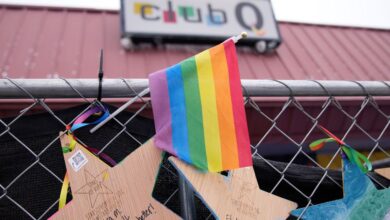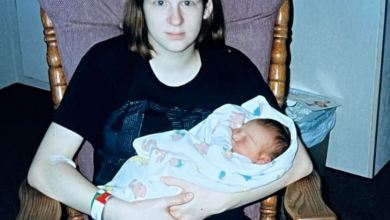How Your Life Experience Could Help You Land a Great Job
Erica Joy Baker has had a succession of dream jobs in Silicon Valley—at Google, at Slack, and now as a senior engineering manager at Patreon, a crowdfunding platform that connects artists with donor-fans. But back in the day, in 1998, she was just an 18-year-old computer geek, sitting in her dream class at her dream school, getting the stink eye from her computer science professor and trying not to cry.
The military brat from Fairbanks had been a self-taught tinkerer, whiling away adolescent hours poking around Microsoft Windows registries and prying the backs off computer cases. Her skills earned her a ticket out of Alaska, to a Florida campus just a short drive from the beach. “I was super fed up with being in a seriously cold place,” she recalls.
But as one of two black students and the only black woman in an entry-level class of hundreds, Baker felt a cold shoulder and took it personally. The professor, a white man, ignored her questions, even as he engaged enthusiastically with white male students. “Every time I talked to him, he made it clear that he didn’t think I should be there,” she says. Her teenage brain wondered if this was a sign of things to come. “I thought, Well, maybe he’s right. Maybe computer science wasn’t for me.”
Baker quit school after a year and went back to Alaska. But so many of the elements that hinted at her future success were hidden in plain sight—if only someone had bothered to ask about them.
Leah Fasten
Her biological dad, who grew up in Florida, had been so poor that he sometimes skipped school to sell oranges by the roadside to raise cash for food. She moved with her family three times before she was 10, but she thrived where other kids crumpled. And she had a knowledge bank about computer systems on par with any of her college classmates. Indeed, that expertise helped her land an IT internship in the University of Alaska system, where she enrolled after returning home—which soon became a real job. “I wasn’t even 20, and I was making $41,000 a year, more than my [step]father,” she recalls, still sounding incredulous. “And I planned to keep going.”
In 2005, Baker came across a Google job ad on Craigslist; by 2006 she had been hired as an IT field tech. The ensuing years brought big wins and promotions, but also stinging setbacks, as managers waved off her contributions or ignored her concerns, giving her something like the professor’s stink eye all over again. “I can’t say for sure why, or that Google missed every opportunity with me, but they did miss most of them,” Baker says.
Read more: 6 CEOs Who Beat the Odds to Reach the Corner Office
After nine years, the sum of the fizzles and false starts led her to look elsewhere. She found better environments at Slack and Patreon, where leadership made a stronger effort to be inclusive—and where, not coincidentally, she became a key player in the exponential growth of two of the Valley’s hotter startups.
Today, Baker is a board member for nonprofits that help girls and underrepresented minorities get a foothold in tech. And her journey has given her insight with profound implications for businesses. “In the tech industry, our interview processes have always been geared to finding a specific kind of person,” says Baker, who has been on both sides of the interview table. “That person usually ends up being a white guy from a very specific set of schools. Like, not me.” And, as she candidly tells gatherings of folks like herself: not you either. To get in the door, she says, “you have to be prepared to show them who you are.”
It’s not just tech: In every company, there’s a tendency to cling to an ideal candidate, exemplified by the person at the top of the org chart. “If you only look for that person, you will find them,” says Joelle Emerson, founder and CEO of Paradigm, a consultancy focused on making companies more inclusive. But there’s a danger inherent in the self-replicating, check-the-boxes approach: Companies risk becoming homogeneous and insular, cut off from the insights and ideas they need to innovate and compete. More ominously, it’s a threat to the social fabric, widening the divide between the economic elite and everybody else.
That’s why growing numbers of employers and talent scouts are considering signs of potential that standard credentials don’t capture—and that transcend lines of race, income, and class. As Geoff Colvin notes in this issue (see “How to Profit from the Ultra-Tight Job Market Right Now”), they’re increasingly skeptical of educational attainment as a proxy for performance. They’re looking for accomplishments that fall outside conventional rubrics: “maker” portfolios of designs and inventions; entrepreneurial achievements; a rich volunteer life; and, more broadly, an ability to creatively manage the sometimes-difficult elements of the life they were born into. In this search, “grit,” the term popularized in the 2016 bestseller of the same name by psychology professor Angela Duckworth, has become the hot shorthand. It’s loosely defined as courage, perseverance, resilience, creativity, a knack for problem–solving and an openness to learning.
“I pattern-match for grit,” says Arlan Hamilton, founder of Backstage Capital, an early-stage investment fund that backs black, female, and LGBTQ entrepreneurs. In her experience, grittier candidates accept feedback better, work harder, and bounce back faster from setbacks than entrepreneurs who went from prep school to the Ivy League to an MBA and beyond. Imagine a candidate who’s a 40-year-old, black single mom who graduated from college while working full-time. She probably knows some things about planning, resolve, multitasking, and stretching a quarter into a dollar, Hamilton says. “And I can make a good bet that she won’t give up.”
Read more: How to Make Your Next Job Interview Count
Grit isn’t a panacea. Unless carefully considered, the search for grit can become a check-the-box diversity exercise of its own: Without thoughtful efforts to find strong candidates and create environments that support them, it’s doomed to disappoint. (It can also fuel ugly stereotypes in which success for the downtrodden depends on charity from white saviors.) That’s why Fortune recommends a reframing: Think of grit less as an antidote to a hard-knock life and more as an ongoing quest to master life complexity—an experience all of us share. When recognition of that complexity shapes hiring, it opens transformative opportunities to people from groups underrepresented in top professions: ethnic minorities, stay-at-home parents, working-class kids, veterans. And in a world locked in a tight global battle for talent, it helps companies find people who are resilient and creative in the face of obstacles.
“People who go to the right schools at the right time, get to know the right people and get the right interview, that’s their path, and they glide over it,” says Baker. The people who didn’t have access to that path? “Maybe their life looks slanted, or diagonal, or they had to double back, but they got to that same place. You know what? Those are the people who succeed.”
Companies struggle to find such candidates in part because of bad-habit shortcuts. “If you said everyone at Salesforce had to have a computer science degree from [the same] five schools, the talent pool would be super-shallow,” says Tony Prophet, chief equality officer at Salesforce, whose job involves combating that reflex. Referrals, similarly, often fail to deliver. Ask a roomful of high-achieving, top-college graduates to find potential new coworkers, and they’ll likely deliver a binder full of candidates who look like themselves.
“What we hear often from companies is that people of color aren’t applying,” says Mimi Fox Melton, director of community mobilization for Code2040, a nonprofit focused on developing black and Latinx leadership in tech. “They have to learn to make a distinction between ‘there aren’t any black people,’ and ‘we don’t know any black people.’ ” And odds are those same decision-makers don’t know any single moms, or poor kids from rural counties.
Leah Fasten
New tactics, like recruiting from historically black universities, community colleges and workforce development programs, are widening the applicant pool. But they won’t help the next gritty executive-in-the-rough make it past the first interview. The trick, for employers, is to normalize the notion that business acumen doesn’t always come in the same forms. Decision-makers need to think differently about everything from the science of résumé-reading to the fine art of conversation.
Much of the fight for inclusive hiring has focused on battling preconceptions that prevent interesting candidates from getting in the door. Training about implicit bias, the way stereotypes unconsciously affect our choices, is becoming the norm at larger companies. Employers are also attacking bias by making people disappear—hiding applicants’ identities with résumé screens, or using anonymized third-party assessment platforms to eliminate the chance that interviewers will show unintentional favoritism while, say, reviewing an applicant’s sample code.
Once you reach the face-to-face stage, retooling the interview process can help nontraditional candidates, says Paradigm’s Emerson. Make sure that candidates meet a diverse panel of interviewers who deliver a uniform experience to everyone. Give them questions they can reflect on ahead of time, to help them think more deeply about how their experiences might dovetail with a company’s needs. “Interviews don’t have to be quizzes,” says Emerson.
And there are creative ways to get to know the real person lurking behind a meager LinkedIn page. Mary Beth Wynn, head of people for Jellyvision, a benefits software maker, says her company de-emphasizes résumés in favor of the cover letter, which she says is “an opportunity to explain why, if their résumé doesn’t look like a fit for the job, they actually are.” Promising candidates are brought in for “auditions,” joining a team for a day to do real work. One applicant, who worked as a nanny, applied for a recruiter job. The audition included, ironically, scanning résumés and cover letters, as well as designing interview questions. She killed it. It turned out her nanny client also owned a small business, Wynn explains; her uncredited experience as the client’s multitasking personal assistant prepared her nicely for the job she was ultimately hired for.
Such workarounds can go only so far, of course. Melton, of Code2040, describes an episode at one tech firm: When reporting how a subject fared during a technical skills assessment, the interviewer noted on the applicant’s file, “He’s not qualified, he’s really ‘street.’ ” Melton says reactions like this are “incredibly common,” a racist dismissal based on “culture fit.” Such reactions reflect entrenched corporate biases—and squander opportunities for employers to connect with people who may well have the tools to do the job.
“None of this is rocket science,” says Porter Braswell, cofounder of Jopwell, an online job platform that connects students and young professionals of color to big employers. “If you’re from the majority culture, and you’re trying to hire someone different from you, you need to have a human-type conversation,” he says. On a practical level, that means looking up from a skimpy résumé and seeing possibility, being open to how an applicant’s experiences are signposts of strength. It’s crucial to “get those stories out,” he says, because “if they have achieved success in their world, you should be able to figure out how they can achieve success in yours.”
There were times when just getting through high school felt like an unattainable goal for Marcus Stevenson. “Neither of my parents did,” explains the Bay Area native. His life plan was an athletic career: He played basketball, his great love, then switched to the gridiron, but injuries snuffed out the exhilaration. School, meanwhile, left a bad taste in his mouth. “I was lost and confused and needed a push,” he says. When none came from outside, he provided it himself, making it to community college, where he earned an associate degree in social science. Stevenson was daunted by the cost of a bachelor’s degree, however, and he was working full-time at a mom-and-pop grocery store when a techie friend told him about Year Up, a rigorous workforce development program focused on urban youth.
Leah Fasten
Stevenson got in and took a full load of technical and professional-skills classes; he also became president of the local Toastmasters public-speaking group. “It was one of the greatest, hardest experiences of my life,” he says. His performance earned him an invitation to a Salesforce networking event, where, amid canapés and chitchat, he “got [his] smile on” and introduced himself to Prophet, the equality officer. Stevenson’s story of disappointment and determination won Prophet over—the 23-year-old was a case study in life complexity, with strengths a résumé would only hint at. “He put himself on a different path and wanted to be a role model,” says Prophet. Today that path runs through Salesforce, where Stevenson works for Prophet as a program coordinator—and recently showed his poise by leading a panel discussion in front of the Congressional Black Caucus.
Workforce development groups like Year Up are crucial to bridging gaps between grit candidates and Fortune 500 companies. While such organizations have been around for generations, new ones are sprouting rapidly, especially in tech, where the demand for flexible, resilient talent grows by the hour. Salesforce’s experiences with Year Up encouraged the company to partner with Deloitte on a pilot program called Pathfinder, in Indiana, home of Salesforce’s second-biggest hub. Pathfinder prepares nontraditional candidates—including “opportunity youth” (people between ages 16 and 24 who are neither in school nor working), veterans, and stay-at-home parents returning to work—for careers in software development and data management, with leadership development and professional skills training included. It’s designed to train people who have the drive but not the credentials to get through a traditional résumé screen, helping them reach the next level.
Scott McIntyre
Other companies, meanwhile, are integrating the hunt for life complexity in their talent searches. Ken Bouyer, Americas director of inclusiveness recruiting for consultancy EY, crisscrosses the country to visit undergrad and graduate business schools, aiming to make accounting more attractive to students of color. Promising students with a 3.5 GPA or better are invited to apply to EY’s Launch internship program. Something in Bouyer’s universe is working: In fiscal 2017, ethnic minorities made up 39% of EY’s roughly 9,200 entry-level hires and 41% of its intern hires. Bouyer himself started as an EY intern—and stayed 27 years. On his campus visits, he starts conversations in which he shares his own grit. “I’ve been working since I was 12 years old, commuted to high school an hour and a half each way, doing my homework on the bus,” says the Queens native. “I tell [students], ‘Success is about the little things you do when nobody else is looking.’ ”
Little things helped Nelly Zorrilla earn a place at EY. Zorrilla has worked since 2016 as an assurance senior in EY’s Stamford, Conn., office, where she helps clients ensure their financial reporting is accurate. For the -Panamanian-American, it’s just the opening act of a great career. “I pictured myself as a ‘boss lady’ at a young age,” she says. Zorrilla is a first-generation American from a tight-knit family in the Bronx—her father did odd jobs, and her mother owns a nail salon, where Zorrilla ran the desk and booked appointments. “Sometimes I still do,” she says, laughing. Zorrilla became a Launch intern while studying at Pace University in Manhattan. When it was time to interview for a move from internship to a full-time position, EY matched her with a kindred spirit, a partner named Amelia Caporale. Sacrifice, self-sufficiency, and love are in Zorrilla’s operating system, and Caporale was astute enough to probe for insights about how those values shaped her work ethic and her dreams. “She asked about what motivated me, and understood how much of what I do is for my family, to thank them,” recalls Zorrilla. The future boss lady was evident, “even if I didn’t look the part. And she saw that. She saw me.”
The hard thing about really talking—having conversations where a Nelly Zorrilla or a Marcus Stevenson can shine—is that it requires both speakers to be vulnerable, to trust each other. “It comes down to authenticity,” says Prophet. “That means opening up, telling your own story, and letting people see you.” And those conversations can’t stop with the job offer. They’re the kind of talks that Erica Joy Baker feels she was missing at Google—and the ones that forward-thinking companies are building into their management processes.
Patrick James Miller
Consider Starbucks, which has pushed to diversify its huge workforce, hiring refugees and opening stores in economically neglected communities of color like Ferguson, Mo., and Jamaica, Queens. When Kevin Johnson, Starbucks’ CEO since April, makes field visits to get to know his employees, he eschews interviews or presentations in favor of informal talks, over coffee, with groups of six or so. They start with a simple prompt: How did you get to Starbucks? “The most amazing stories are told, and people share very vulnerable things about their lives,” Johnson says. Where they’ve struggled, where they’ve been helped, what they hope the future holds. “It’s where you learn to listen with your heart.” And that, he adds, “leads to empathy and compassion for others.”
The dynamic flows to the bottom line, Johnson says: When employees feel more welcome, so do customers. But managers who follow his example become stronger leaders too. “You’ll think about risk differently,” he promises. “You will make better decisions.”
A version of this article appears in the Feb. 1, 2018 issue of Fortune with the headline “Grit Is the New MBA.”





